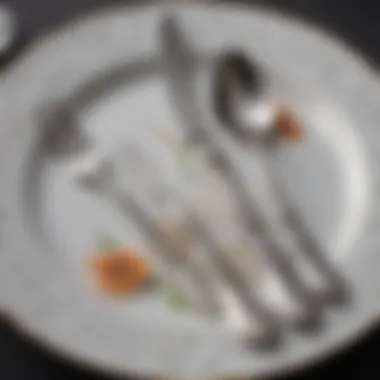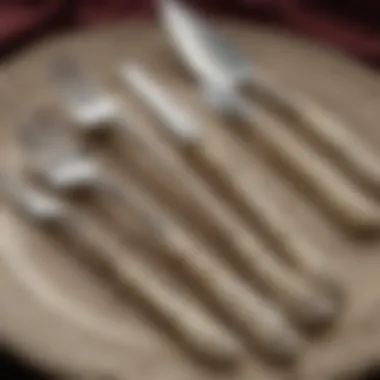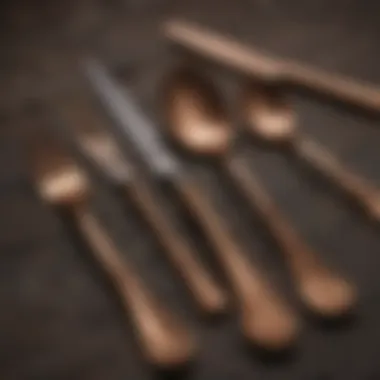Unveiling the Realm of Flatware: A Detailed Guide for Connoisseurs


Rock and Fossil Identification
When delving into the world of flatware, collectors often seek a deep understanding of the various types of materials used in crafting these essential dining utensils. From classic stainless steel to ornate silverware, each material brings its own characteristics and allure to the table. By examining the intricate patterns and designs etched into flatware pieces, enthusiasts can unlock the secrets of craftsmanship embedded in every fork, spoon, and knife. Tools such as magnifying glasses and metal detectors prove invaluable in identifying unique patterns and distinguishing key features that elevate a piece of flatware from mundane to exceptional.
Collecting Tips and Techniques
The pursuit of rare and remarkable flatware requires collectors to adhere to best practices when searching for prized additions to their collections. Locating prime collecting sites, whether through antique stores or online auctions, demands a keen eye and a discerning taste. Knowing how to safely extract specimens, whether delicately removing tarnish or showcasing intricate engravings, is crucial in preserving the integrity and value of each piece. Seasoned collectors advise newcomers on the importance of researching manufacturers, historical timelines, and market trends to make informed decisions and curate a collection that tells a unique and captivating story.
Preservation and Display
As guardians of history and craftsmanship, collectors must employ various techniques to preserve flatware for generations to come. Proper storage methods involve utilizing acid-free materials, protective coatings, and climate-controlled environments to prevent corrosion, discoloration, and other forms of degradation. Creative display ideas abound, from elegant showcases and museum-style cabinets to innovative DIY projects that showcase flatware as both functional tools and works of art, enhancing any dining experience with a touch of elegance and sophistication.
Historical Significance and Artistry
Beyond the utilitarian roles they serve, flatware pieces hold significant historical and cultural value, reflecting the evolving preferences and trends of different eras. From intricate Rococo patterns to minimalist Modernist designs, the evolution of flatware mirrors broader art and design movements, offering collectors a window into the past. Notable discoveries in the field, such as rare prototypes or limited-edition sets, ignite the passions of collectors worldwide, driving the hunt for hidden treasures and forgotten masterpieces that enrich our understanding of society and craftsmanship throughout the ages.
Introduction to Flatware
In the vast realm of culinary tools and dining culture, the significance of flatware stands out as a fundamental aspect that bridges functionality and artistry. This section of the article serves as a gateway into the captivating world of flatware, setting the stage for a profound exploration of its various dimensions. As collectors and enthusiasts delve into the nuances of flatware, understanding its essence becomes paramount in appreciating the craftsmanship behind each piece. From its historical roots to its modern interpretation, the Introduction to Flatware offers a holistic view of these essential dining utensils.
Definition of Flatware
Understanding the term 'flatware'
In the realm of dining etiquette and culinary aesthetics, the term 'flatware' encapsulates the essential utensils used for eating and serving food. From simple forks and spoons to intricate serving pieces, flatware plays a pivotal role in enhancing the dining experience. Understanding the term 'flatware' delves into the functionality and form of these utensils, shedding light on their significant contribution to the art of dining. Its versatility and practicality make it a cornerstone in table settings worldwide, reflecting cultural preferences and culinary traditions.
Origins and evolution of flatware
The evolution of flatware dates back centuries, influenced by cultural shifts, technological advancements, and design trends. From its humble beginnings as basic eating tools to its modern incarnations showcasing intricate designs and materials, flatware has evolved remarkably. Exploring the origins and evolution of flatware unveils a timeline of innovation and craftsmanship, providing insights into how these utensils have transformed over time. This historical perspective not only enriches collectors' appreciation but also highlights the ingenuity and creativity embedded in each flatware piece.
Importance of Flatware
Role of flatware in dining etiquette
Beyond its utilitarian function, flatware plays a crucial role in defining dining etiquette and presentation. Each piece of flatware has a designated purpose and position, contributing to the overall dining experience. Understanding the role of flatware in dining etiquette unveils a world of subtle gestures and traditions that enhance the mealtime ritual. Through proper placement and usage, flatware elevates the aesthetics of dining, reflecting sophistication and attention to detail.


Symbolism and cultural significance
Flatware carries symbolic meanings deeply rooted in cultural traditions and societal values. From ceremonial pieces to everyday utensils, flatware symbolizes social status, hospitality, and personal taste. Exploring the symbolism and cultural significance of flatware unveils a tapestry of customs and beliefs woven into each design. Understanding these symbolic nuances enhances collectors' appreciation for flatware as more than just functional objects but as tangible expressions of history and heritage.
Types of Flatware
Exploring the different types of flatware is a crucial aspect of this comprehensive guide for collectors. Understanding the diversity and functionality of flatware can provide valuable insights into the craftsmanship and history behind these essential dining utensils. By delving into the various types of flatware, enthusiasts and collectors can appreciate the intricacies of design and purpose that make each piece unique and culturally significant.
Common Types of Flatware
Forks, Spoons, Knives
The fundamental components of flatware – forks, spoons, and knives – play a vital role in dining experiences. Forks are designed for ease of piercing and lifting food, spoons for scooping and holding liquids, and knives for cutting and spreading. Each type showcases specific characteristics that cater to different dining needs, enhancing both the practicality and aesthetic appeal of the dining table.
Focusing on the functionality of forks, spoons, and knives within the realm of flatware allows collectors to discern the nuanced details that define each piece. In this article, the significance of these common types of flatware lies in their ubiquitous presence in dining settings and their timeless functionality that transcends cultural boundaries.
Differentiation Based on Function
The differentiation of flatware based on function provides collectors with a deeper appreciation for the specialized roles that various pieces play. Whether it's salad forks, dessert spoons, or steak knives, understanding the specific functions of each type of flatware allows for a more curated and sophisticated dining experience.
By highlighting the differentiation based on function in this article, readers can grasp the subtle yet impactful distinctions between flatware pieces. This knowledge empowers collectors to select the appropriate utensils for different culinary occasions, showcasing not only their discerning taste but also their understanding of the artistry behind functional design.
Specialized Flatware
Dessert Utensils, Seafood Tools
Delving into specialized flatware, such as dessert utensils and seafood tools, unveils the intricate care and consideration put into designing pieces for specific culinary purposes. Dessert utensils, tailored for sweet indulgences, feature delicate designs that complement after-dinner treats, while seafood tools, suited for cracking and extracting shellfish, exhibit sturdy and efficient craftsmanship.
Discussing dessert utensils and seafood tools in this article sheds light on the meticulous details that elevate dining experiences. By exploring the unique features of these specialized flatware pieces, collectors can add a touch of sophistication to their table settings and showcase their appreciation for culinary nuances.
Unique Serving Pieces
Unique serving pieces serve as focal points during dining occasions, exuding elegance and functionality in equal measure. From ornate serving forks to intricately designed ladles, these pieces not only facilitate food presentation but also enrich the overall dining atmosphere with their artistic flair and tailored functionality.
Highlighting the unique characteristics of serving pieces in this article accentuates their significance in enhancing the dining experience. By examining the advantages and disadvantages of unique serving pieces, collectors can make informed decisions about incorporating these standout items into their collections, further elevating their dining occasions.


Materials Used in Flatware
Flatware's materials are integral to its quality, aesthetics, and practicality, making this aspect a crucial focus in this comprehensive guide for collectors. Understanding the materials used in flatware provides insights into their durability, maintenance requirements, and overall value. By delving into the various materials, enthusiasts can appreciate the craftsmanship and history behind each piece.
Common Materials
Stainless Steel, Silver, Gold
Stainless steel, silver, and gold are primary materials in flatware production, each bringing its unique characteristics and allure to the table. Stainless steel is prized for its durability, resistance to corrosion, and affordability, making it a popular choice for everyday use. Silver, known for its elegance and luster, adds a touch of sophistication to dining settings, often reserved for special occasions. Meanwhile, gold accents exude luxury and opulence, elevating flatware to a status symbol among collectors.
In this article, the emphasis on stainless steel, silver, and gold underscores their significance in the realm of flatware, highlighting their distinct qualities and appeal to collectors seeking both functionality and aesthetics.
Alternative Materials and Their Properties
Apart from traditional materials, alternative options offer versatility and distinct design possibilities in flatware crafting. Materials like titanium, wood, and plastic bring creativity and eco-consciousness to the table, appealing to modern collectors with diverse preferences. Titanium, for instance, combines strength and lightweight properties, ideal for contemporary flatware designs. Wood infuses a natural, rustic charm to utensils, creating a unique sensory experience for users. Plastic, although unconventional, presents affordability and endless color options, catering to a younger demographic seeking customization and vibrancy in their dining experience.
Exploring alternative materials in this article showcases the innovation and adaptability within flatware design, presenting collectors with a spectrum of choices beyond traditional metal compositions.
Quality and Durability
Factors Affecting Longevity
The longevity of flatware is influenced by various factors, including material quality, construction techniques, and usage patterns. Higher-grade materials like 18/10 stainless steel and sterling silver exhibit superior durability and tarnish resistance, ensuring long-lasting performance even with frequent use. Factors such as proper storage, handwashing techniques, and avoiding harsh detergents contribute to preserving the integrity of flatware over time.
This section articulates the paramount importance of selecting high-quality materials and adopting suitable care practices for enhancing the longevity of flatware pieces, underlining the value of investing in durable utensils that age gracefully.
Care and Maintenance Tips
Maintaining flatware requires a blend of attentive care and best practices to uphold its condition and appearance. Simple steps like handwashing with mild soap, thorough drying to prevent water spots, and periodic polishing to remove tarnish are essential for preserving the lustre and longevity of flatware. Additionally, storing utensils in felt-lined drawers or protective sleeves shields them from scratches and dings, prolonging their pristine state for years to come.
Offering practical insights and detailed guidance on caring for flatware in this article equips collectors with the knowledge to safeguard their cherished pieces, emphasizing the significance of regular maintenance in preserving the beauty and functionality of flatware.
Identifying Flatware
In the realm of flatware, the ability to accurately identify different sets and patterns holds significant importance. This section of the comprehensive guide on exploring flatware delves into the intricate world of identifying flatware, shedding light on the key elements that collectors and enthusiasts should pay close attention to. Understanding the origin, age, and design of a piece can provide essential insights into its value and history. By honing the skill of identifying flatware, individuals can distinguish between various patterns, materials, and craftsmanship styles, enhancing their overall appreciation and collection.


Recognizing Flatware Patterns
Popular Design Motifs
The intricate patterns adorning flatware play a pivotal role in defining its aesthetic appeal and historical significance. Popular design motifs, such as floral patterns, geometric shapes, and intricate engravings, serve as distinctive markers of different eras and design movements. These motifs not only showcase the artistry of craftsmen but also reflect the cultural influences and trends of their time. Collectors and enthusiasts often gravitate towards specific motifs based on personal preferences or historical interests, making them sought-after pieces in the world of flatware.
Tools and Resources for Pattern Identification
Identifying and verifying flatware patterns require precision and expertise, which is where specialized tools and resources become invaluable. From magnifying glasses and pattern books to online databases and expert forums, collectors have a plethora of resources at their disposal to aid in pattern identification. These tools not only facilitate the identification process but also offer insights into the historical context and rarity of specific patterns. By leveraging these resources, collectors can confidently attribute patterns to specific designers, manufacturers, and time periods, enriching their understanding and appreciation of flatware.
Hallmarks and Signatures
Understanding the hallmarks and signatures found on flatware pieces is essential for tracing their origins and authenticity. Manufacturer marks engraved on the underside of flatware items often reveal crucial information about the maker, production location, and materials used. By deciphering these marks, collectors can unravel the provenance of a piece and determine its value in the market. Additionally, signatures left by renowned designers or craftsmen add prestige and value to flatware pieces, showcasing the collaboration between artistry and functionality.
Interpreting Date Codes
Date codes embedded in hallmarks or manufacturer stamps offer valuable insights into the age and provenance of flatware items. These codes, often represented as letters, numbers, or symbols, correspond to specific years or production periods, allowing collectors to establish a timeline for their pieces. By decoding these date marks, enthusiasts can authenticate their collection, identify rare or limited-edition pieces, and contextualize their flatware within the broader historical landscape. The ability to interpret date codes adds layers of historical depth and significance to flatware collections, making the process of collecting even more captivating and rewarding.
Historical Significance of Flatware
Flatware holds a significant place in history, serving as more than just functional dining utensils. In this comprehensive guide, we delve into the historical significance of flatware, unearthing its evolution through different eras. Understanding the historical context of flatware provides valuable insights into the cultural and social dynamics of civilizations across time.
Era-specific Styles
Baroque, Art Nouveau, Modernist
Baroque, Art Nouveau, and Modernist are not only art movements but also design styles that have influenced the creation of flatware. Each style carries distinct characteristics that reflect the artistic trends of its respective era. Baroque exudes opulence and intricate ornamentation, making it a popular choice for collectors seeking elaborate and ornate pieces. Art Nouveau, with its fluid lines and nature-inspired motifs, represents a departure from traditional designs, appealing to those looking for unique and artistic flatware. Modernist design emphasizes simplicity and functionality, attracting individuals who appreciate minimalist and contemporary aesthetics.
Influential Designers and Movements
In the realm of flatware design, certain designers and movements have left a lasting impact on the industry. Their innovative approaches and visionary concepts have shaped the way we perceive and appreciate flatware today. By exploring the work of influential designers and their contributions to the evolution of flatware, collectors gain a deeper appreciation for the craftsmanship and artistry involved. Understanding these influences provides a holistic view of flatware design, from traditional to avant-garde.
Royal and Commemorative Flatware
Monarchical Collections
Monarchical collections offer a glimpse into the extravagant world of royalty, showcasing flatware that embodies luxury and refinement. These pieces often feature intricate detailing, precious materials, and royal crests, serving as symbols of status and heritage. Collectors fascinated by regal history are drawn to monarchical collections for their historical significance and exquisite craftsmanship.
Special Occasion Pieces
Special occasion pieces hold sentimental value, commemorating significant events or milestones in a person's life. Whether it be a wedding, anniversary, or achievement, these pieces add a touch of elegance and sentimentality to celebratory moments. Crafted with precision and care, special occasion flatware reflects the importance of the occasion it represents, making it a meaningful addition to any collection.







